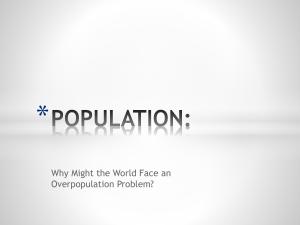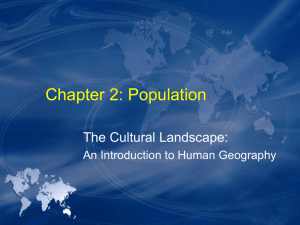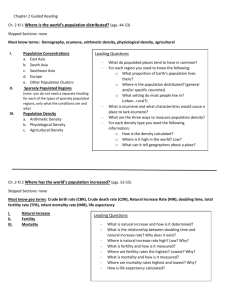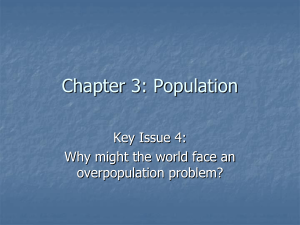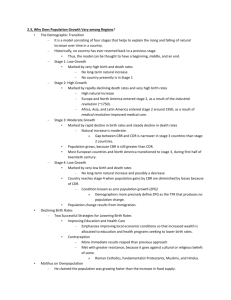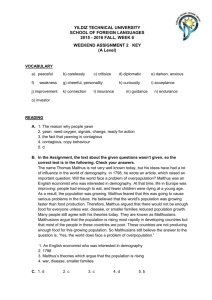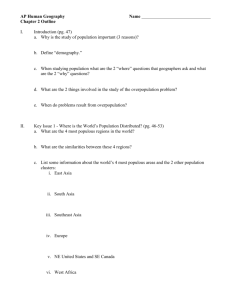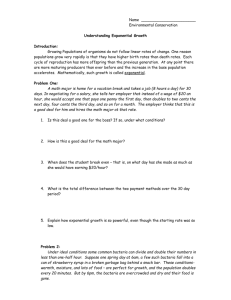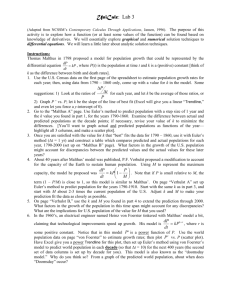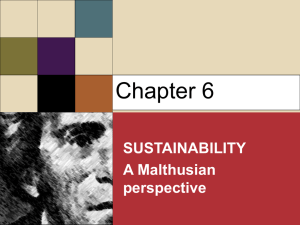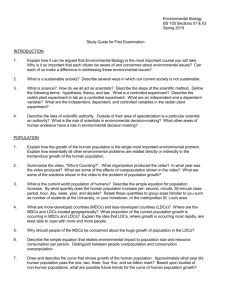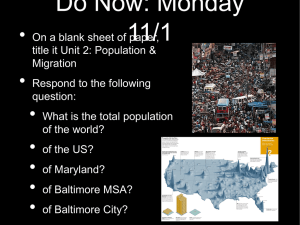Key Issue #4- Chapter 2
advertisement
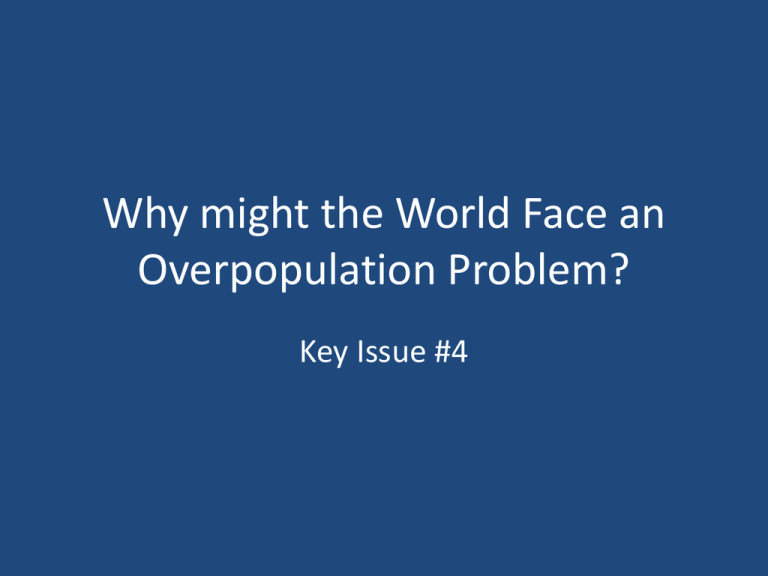
Why might the World Face an Overpopulation Problem? Key Issue #4 Malthus A. Malthus I. Who is Malthus?- published An Essay on the Principle of Population, in 1798 II. Hypothesized: population was growing much more rapidly than the Earth’s food supply because the population increased geometrically, where as food supply increased arithmetically III. Population would grow until: “morale restraint” produced lower CBRs or unless disease, famine , war or other disasters produced lower CBRs Neo-Malthus B. Neo-Malthus I. What did Malthus fail to realize? Failed to anticipate that relatively poor countries would have the most rapid population growth because of transfer of medical technology, but not wealth from MDCs Result: gap between population growth and resources is wider in some countries than even Malthus anticipated II. Believe that overpopulation is outstripping resources as well as food People will be engaged in a desperate search for food and energy Wars and civil violence will increase in the coming years because the scarcities of food as well as such resources as clean air, suitable farmland, and fuel Anti-Malthus C. Anti-Malthus I. What are dome arguments against Malthus? 1. Possibilism: our well being is influenced by conditions in the physical environment, but humans have some ability to choose courses of action that can expand supply of food and resources A. 2. Steady flow of technology can offset scarcity of minerals and arable land Boserup and Kuznets: larger population growth could stimulate economic growth and therefore production of more food, could generate more customers and more ideas for improving technology Anti-Malthus 3. Simon: population growth stimulated economic growth a. More people means more brains to invent good ideas for improving life 4. Marxists: maintain that no cause and effect relationships exists between population growth and economic development a. Poverty and hunger and other social welfare problems associated with lack of economic development are a result of unjust social and economic institutions 5. Politicians in Africa: high population growth is good for a country because more people will result in greater power a. More young men= more soldiers in the armies D. Reality 1. 2. 3. Population growth and food production have been able to keep up because world food production has grown at a faster ate than the NIR since 1950 Better growing techniques, higher-yielding seeds, and cultivation of more land contributed to the expansion in the food supply Many people in the world cannot afford to buy food or do not have access to food , problem is with a distribution of wealth rather insufficient global production of food Declining Birth Rates E. Declining Birth Rates- How does it slow down the NIR? I. Economic Development 1. 2. Improving local economic conditions; wealthier communities can spend more money on education and health-care programs that would promote lower birth rates Women are able to attend more school and remain in school longer, they are more likely to learn employment skills and gain more economic control over their lives Better education: understand their reproductive rights Make more informed reproductive choices Select more effective forms of contraceptives Declining Birth Rates II. Contraceptive Distribution 1. 2. World cannot wait around for economic developments to happen; contraception is quick and immediate, and cheap Bangladesh, Colombia, Morocco, and Thailand are good of examples of the use of contraception 3. Rapid growth in the acceptance of family planning is occurring more frequent around the world Obstacles in contraceptive Distribution: economics, religion, and education Women with high birth rates show their high status and men regard it as a sign of their virility in some societies Epidemiologic Transition F. Epidemiologic Transition i. Focuses on distinctive causes of death in each stage of the DTM ii. Stages 1. 2. Stage 1: Black Plague- transmitted to humans by fleas from infected rats; 25 million Europeans died (1/2 of the continents population); Stage 2: receding pandemics: Cholera; improved sanitation during the IR reduced the spread; Cholera in urban areas became an epidemic Epidemiologic Transition 3. Epidemiologic Transition Stage 3 : Stage 3: degenerative and human-created diseases, decrease in deaths from infectious diseases and increase in chronic disorders associated with aging Cardiovascular disease and various forms of cancer Cases of polio declined in US-vaccines Measles declined-vaccines 4. Stage 4: delayed degenerative diseases Deaths from cardiovascular disease and cancers linger, but medical advances still prolong life Bypass surgeries Better diets Reduce use of tobacco and alcohol exercise Epidemiologic Transition 5. Possible Stage 5: stage reemergence of infectious and parasitic diseases Infectious diseases thought to have been eradicated or controlled have returned, and new ones have emerged Malaria, thought to have eradicated in mid 20th century by spraying DDT; new cases have shown up in Sri Lanka; evolution of DDT-resistance mosquitoes Poverty: TB has been controlled in MDCs but is still a major problem in LDCs, airborne disease contracted through coughing, sneezing, damages the lungs; principal cause of death in 19th century; still prevalent in LDCs because treatment is long and expensive Epidemiologic Transition Improved travel: people carry and are exposed to new diseases; “Bird Flu” infected 258 people as of 2006 and killed 154 AIDS: most lethal epidemic in years; 20 million people have died, 40 million living with HIV; 99% of new cases are in LDCs
